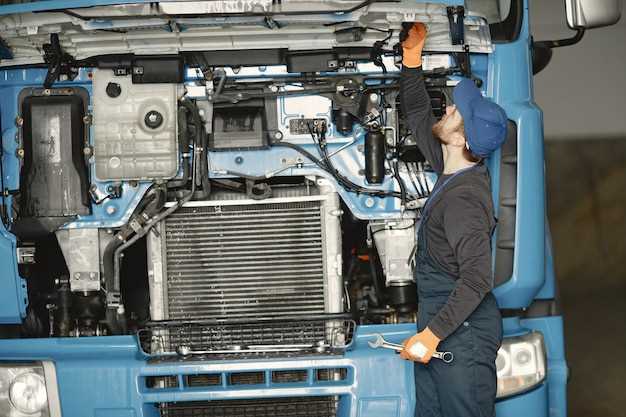
In the ever-evolving world of automotive technology, the importance of investing in diagnostic tools for modern trucks cannot be overstated. With the increasing complexity of truck systems and the growing reliance on electronic controls, a reliable diagnostic tool has become essential for effective maintenance and troubleshooting. Among these tools, scanners have emerged as a vital component, providing real-time access to vehicle data and enabling quick identification of issues.
Truck diagnostics have transitioned from simple mechanical evaluations to sophisticated electronic assessments. This shift necessitates the use of advanced tools, such as OBD (On-Board Diagnostics) scanners, which are designed to interface directly with a truck’s computer systems. By utilizing these scanners, technicians can read error codes, monitor engine performance, and conduct comprehensive system checks, streamlining the repair process and minimizing downtime.
Investing in high-quality diagnostic tools not only enhances the efficiency of repair shops but also improves overall fleet management. With the ability to identify potential faults before they escalate, operators can save on costly repairs and extend the lifespan of their vehicles. In today’s competitive trucking industry, having access to the right diagnostic equipment is not just an advantage; it is a necessity.
Choosing the Right OBD Scanner for Your Truck Model

Selecting the appropriate OBD scanner for your truck is critical for effective diagnostics and maintenance. The first step is to identify the specific OBD protocols your truck model supports. Different manufacturers may implement variations, so it’s essential to choose a scanner compatible with your vehicle’s make and model.
Next, consider the type of OBD scanner that best fits your needs. There are two primary categories: code readers and advanced scan tools. Code readers provide basic functionality, such as retrieving and clearing trouble codes, making them suitable for simple diagnostics. Conversely, advanced scan tools offer in-depth features, including live data monitoring, freeze frame data, and enhanced diagnostics tailored for specific truck models.
Another essential factor is the connectivity options of the OBD scanner. Many modern scanners utilize Bluetooth or Wi-Fi, enabling seamless integration with smartphones and tablets. This functionality allows for easier data interpretation and reporting, especially useful when diagnosing issues on the road.
Look for a scanner with a comprehensive database that provides manufacturer-specific codes. This feature is particularly beneficial for trucks that may have unique systems or functions not covered by generic OBD II codes. A scanner offering expansive support can save time and reduce frustration during diagnostics.
Finally, consider the user interface and update capabilities of the OBD scanner. A user-friendly display and intuitive navigation can help you diagnose issues quickly, while regular updates ensure your scanner remains compatible with the latest vehicle technologies. Investing in a reliable OBD scanner tailored to your truck model can enhance your maintenance practices and prevent costly repairs in the long run.
Understanding Diagnostic Trouble Codes and Their Implications
Diagnostic Trouble Codes (DTCs) are critical for modern truck maintenance and repair, serving as the primary communication tool between the vehicle’s onboard computer and the mechanic or technician using a scanner. These codes allow for efficient diagnostics by pinpointing the specific issues affecting a truck’s performance.
DTCs are generated when the vehicle’s onboard diagnostics (OBD) system detects a fault within its various systems, such as the engine, transmission, or emissions controls. Each code corresponds to a specific problem, enabling technicians to quickly identify malfunctions without extensive investigation. For instance, a malfunctioning oxygen sensor may trigger a particular DTC, guiding the mechanic towards the exact issue rather than necessitating a broad and potentially time-consuming diagnosis.
The implications of understanding DTCs go beyond mere identification of problems. Accurate diagnostics facilitate timely repairs, which ultimately enhance the vehicle’s efficiency and longevity. By addressing issues promptly, fleet operators can reduce downtime, save on repair costs, and improve fuel efficiency, thereby maximizing overall operational effectiveness. Moreover, using a quality scanner not only helps in accessing the DTCs but also provides real-time data and historical records, aiding in both immediate and future maintenance decisions.
Furthermore, recognizing the significance of DTCs emphasizes the importance of investing in sophisticated diagnostic tools. As technology advances, so do the capabilities of diagnostic equipment, allowing for deeper insights into vehicle health. Comprehensive understanding and proactive management of these codes are essential for ensuring optimal truck performance in today’s competitive market.
Cost-Benefit Analysis of Regular Diagnostics for Fleet Maintenance

Regular diagnostics play a crucial role in maintaining the efficiency and reliability of modern truck fleets. The integration of advanced diagnostic tools, such as OBD (On-Board Diagnostics) scanners, allows fleet managers to proactively identify and address issues before they escalate into costly repairs. This analysis delves into the cost-benefit aspects of routine diagnostics and the implications on fleet performance.
Cost Savings from Early Detection: One of the primary benefits of implementing regular diagnostics is the potential for significant cost savings. By utilizing OBD scanners, fleet operators can quickly diagnose engine faults, electrical issues, and other performance-related problems. Early detection minimizes the risk of unexpected breakdowns, which can result in expensive repairs, unplanned downtime, and loss of revenue. Studies show that addressing issues early can save fleets up to 30% on maintenance costs over time.
Enhanced Vehicle Longevity: Regular diagnostics contribute to extended vehicle life. Ongoing monitoring allows for timely repairs and maintenance, ensuring that trucks operate under optimal conditions. Fleet managers who invest in diagnostic tools can avoid the pitfalls of neglect, which may lead to premature vehicle retirement. This proactive approach can improve asset utilization and reduce the overall lifecycle costs of the fleet.
Operational Efficiency Improvements: An efficient fleet directly correlates with increased profitability. OBD scanners provide insights into vehicle performance metrics, allowing managers to optimize routes, monitor fuel consumption, and enhance driver behavior. With regular diagnostics, fleets can achieve better operational efficiency, translating into lower fuel costs and improved delivery timelines.
Regulatory Compliance and Risk Mitigation: Maintaining compliance with industry regulations is vital for fleet operations. Regular diagnostics help ensure that vehicles meet emission standards and safety regulations. Utilizing diagnostic tools minimizes the risk of fines and enhances the fleet’s reputation in the market. Furthermore, a well-maintained fleet can improve insurance premiums by reducing the likelihood of accidents related to mechanical failures.
Conclusion: The cost-benefit analysis of regular diagnostics for fleet maintenance clearly indicates that the initial investment in OBD scanners and diagnostic tools pays off through enhanced performance, cost savings, and risk reduction. Given the competitive nature of the transportation industry, investing in these technologies is not merely an option; it is a strategic necessity for maintaining a robust and efficient fleet.




